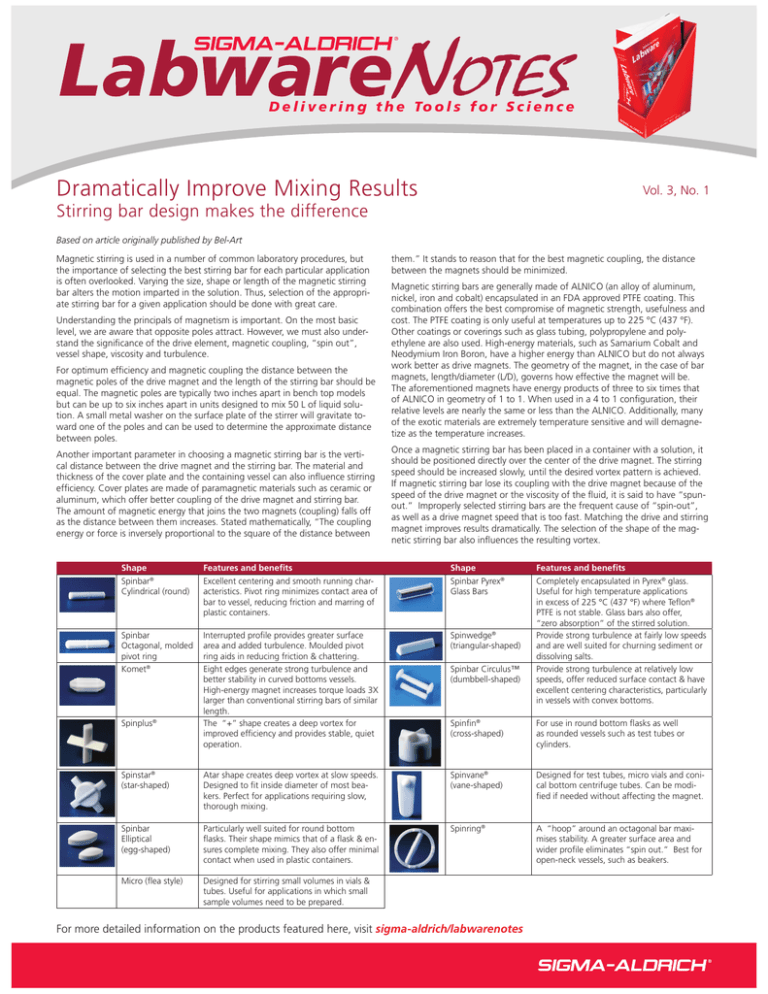
D e l i v e r i n g t h e To o l s f o r S c i e n c e
Dramatically Improve Mixing Results
Vol. 3, No. 1
Stirring bar design makes the difference
Based on article originally published by Bel-Art
Magnetic stirring is used in a number of common laboratory procedures, but
the importance of selecting the best stirring bar for each particular application
is often overlooked. Varying the size, shape or length of the magnetic stirring
bar alters the motion imparted in the solution. Thus, selection of the appropriate stirring bar for a given application should be done with great care.
Understanding the principals of magnetism is important. On the most basic
level, we are aware that opposite poles attract. However, we must also understand the significance of the drive element, magnetic coupling, “spin out”,
vessel shape, viscosity and turbulence.
For optimum efficiency and magnetic coupling the distance between the
magnetic poles of the drive magnet and the length of the stirring bar should be
equal. The magnetic poles are typically two inches apart in bench top models
but can be up to six inches apart in units designed to mix 50 L of liquid solution. A small metal washer on the surface plate of the stirrer will gravitate toward one of the poles and can be used to determine the approximate distance
between poles.
Another important parameter in choosing a magnetic stirring bar is the vertical distance between the drive magnet and the stirring bar. The material and
thickness of the cover plate and the containing vessel can also influence stirring
efficiency. Cover plates are made of paramagnetic materials such as ceramic or
aluminum, which offer better coupling of the drive magnet and stirring bar.
The amount of magnetic energy that joins the two magnets (coupling) falls off
as the distance between them increases. Stated mathematically, “The coupling
energy or force is inversely proportional to the square of the distance between
them.” It stands to reason that for the best magnetic coupling, the distance
between the magnets should be minimized.
Magnetic stirring bars are generally made of ALNICO (an alloy of aluminum,
nickel, iron and cobalt) encapsulated in an FDA approved PTFE coating. This
combination offers the best compromise of magnetic strength, usefulness and
cost. The PTFE coating is only useful at temperatures up to 225 °C (437 °F).
Other coatings or coverings such as glass tubing, polypropylene and polyethylene are also used. High-energy materials, such as Samarium Cobalt and
Neodymium Iron Boron, have a higher energy than ALNICO but do not always
work better as drive magnets. The geometry of the magnet, in the case of bar
magnets, length/diameter (L/D), governs how effective the magnet will be.
The aforementioned magnets have energy products of three to six times that
of ALNICO in geometry of 1 to 1. When used in a 4 to 1 configuration, their
relative levels are nearly the same or less than the ALNICO. Additionally, many
of the exotic materials are extremely temperature sensitive and will demagnetize as the temperature increases.
Once a magnetic stirring bar has been placed in a container with a solution, it
should be positioned directly over the center of the drive magnet. The stirring
speed should be increased slowly, until the desired vortex pattern is achieved.
If magnetic stirring bar lose its coupling with the drive magnet because of the
speed of the drive magnet or the viscosity of the fluid, it is said to have “spunout.” Improperly selected stirring bars are the frequent cause of “spin-out”,
as well as a drive magnet speed that is too fast. Matching the drive and stirring
magnet improves results dramatically. The selection of the shape of the magnetic stirring bar also influences the resulting vortex.
Shape
Spinbar®
Cylindrical (round)
Features and benefits
Excellent centering and smooth running characteristics. Pivot ring minimizes contact area of
bar to vessel, reducing friction and marring of
plastic containers.
Shape
Spinbar Pyrex®
Glass Bars
Spinbar
Octagonal, molded
pivot ring
Komet®
Interrupted profile provides greater surface
area and added turbulence. Moulded pivot
ring aids in reducing friction & chattering.
Eight edges generate strong turbulence and
better stability in curved bottoms vessels.
High-energy magnet increases torque loads 3X
larger than conventional stirring bars of similar
length.
The “+” shape creates a deep vortex for
improved efficiency and provides stable, quiet
operation.
Spinwedge®
(triangular-shaped)
Spinfin®
(cross-shaped)
For use in round bottom flasks as well
as rounded vessels such as test tubes or
cylinders.
Spinstar®
(star-shaped)
Atar shape creates deep vortex at slow speeds.
Designed to fit inside diameter of most beakers. Perfect for applications requiring slow,
thorough mixing.
Spinvane®
(vane-shaped)
Designed for test tubes, micro vials and conical bottom centrifuge tubes. Can be modified if needed without affecting the magnet.
Spinbar
Elliptical
(egg-shaped)
Particularly well suited for round bottom
flasks. Their shape mimics that of a flask & ensures complete mixing. They also offer minimal
contact when used in plastic containers.
Spinring®
A “hoop” around an octagonal bar maximises stability. A greater surface area and
wider profile eliminates “spin out.” Best for
open-neck vessels, such as beakers.
Micro (flea style)
Designed for stirring small volumes in vials &
tubes. Useful for applications in which small
sample volumes need to be prepared.
Spinplus®
Spinbar Circulus™
(dumbbell-shaped)
For more detailed information on the products featured here, visit sigma-aldrich/labwarenotes
Features and benefits
Completely encapsulated in Pyrex® glass.
Useful for high temperature applications
in excess of 225 °C (437 °F) where Teflon®
PTFE is not stable. Glass bars also offer,
“zero absorption” of the stirred solution.
Provide strong turbulence at fairly low speeds
and are well suited for churning sediment or
dissolving salts.
Provide strong turbulence at relatively low
speeds, offer reduced surface contact & have
excellent centering characteristics, particularly
in vessels with convex bottoms.
Paula’s Pointers
Background Reading
Z648280
Spinbar® magnetic stirring bar garage
Z651915
At the Bench: a Laboratory
Navigator, updated edition
Paula Freemantle, Product Manager
Labware@sial.com
Storing stirring bars can be a
problem. They usually end up
rolling around in the bottom of a
drawer. This not only leads to them
being difficult to find, but can also lead to demagnetisation and render the bar useless. A simple
way to keep all your magnetic stirring bars safe
and accessible is with the Spinbar magnetic stirring
bar garage. Multiple sizes and shapes of magnetic
stirring bars from 159 mm (6”) to tiny 10 mm (0.5”)
bars can be stored on the dedicated rack which
stands freely on the bench or can be mounted to
a vertical surface. Tight wire spacing in the upper
section of the rack holds smaller magnetic stirs
bars, keeping them separate from larger bars stored
below. A lower wire shelf holds small lab tools and
prevents stirring bars from accidentally falling.
At the Bench is the unique and
extremely successful handbook for
living and working in the laboratory,
an essential aid to understanding
basic lab techniques and how
research groups work at a human
level. In this newly revised edition,
chapters have been rewritten to accommodate the impact
of computer technology and the Internet, not only on the
acquisition and analysis of data, but also on its organization
and presentation. Alternatives to the use of radiation have
been expanded, and figures and illustrations have been
redrawn to reflect changes in laboratory equipment and
procedures.
Latest News
The 2009-2010 Labware Catalog and Aldrich® Handbook of Fine Chemicals set is now available!
Labware Catalog content includes:
• Approximately 1,300 pages with over 16,000 carefully selected products for Chemistry and Life Science customers/applications
• Comprehensive index and thumbnail pictures for easy navigation
• New technical information section with12 pages of useful charts, graphs and section guides
To request your 2009-2010 Labware Catalog and Aldrich Handbook of Fine Chemicals, visit sigma-aldrich.com/aldrich_handbook
Research is easier when you use the right tools!
Labware Listens
In response to a huge increase in customers asking for small footprint
mixing equipment, Labware has increased the range of mini-units offered.
Joining the Lab Dancer vortexer from IKA we have the new mini-LabRoller
and Gyro-mini units from Labnet. These models enable you
to make the best use of your bench space by
combining full operational specifications
with a highly compact footprint.
More details can be found at
sigma-aldrich.com/labwarenotes
Down Time
9
9
2
7
8
6
5
4
1
8
5
3
5
2
3
6
9
1
1
5
Labware Links
4
2
8
Sudoku is a logic-based numberplacement puzzle. The objective
is to fill a 9×9 grid so that each
column, each row, and each of
the nine 3×3 boxes contains the
digits from 1 to 9 only one time
each. Completed Sudoku puzzles
are usually a type of Latin square
with an additional constraint on
the contents of individual regions.
Sudoku means “single number” in
Japanese.
7
For more detailed information on the products featured in this newsletter
along with back issues and many useful Labware web links and protocols
visit sigma-aldrich.com/labwarenotes
World Headquarters
Order/Customer Service (800) 325-3010 • Fax (800) 325-5052
3050 Spruce St., St. Louis, MO 63103
(314) 771-5765
sigma-aldrich.com
Technical Service (800) 325-5832 • sigma-aldrich.com/techservice
Development/Bulk Manufacturing Inquiries
(800) 244-1173
©2009 Sigma-Aldrich Co. All rights reserved. SIGMA, , SAFC,
, SIGMA-ALDRICH, ALDRICH, , FLUKA, , and SUPELCO,
are trademarks belonging to Sigma-Aldrich Co.
and its affiliate Sigma-Aldrich Biotechnology, L.P. Sigma brand products are sold through Sigma-Aldrich, Inc. Sigma-Aldrich, Inc. warrants that its products conform to the information
contained in this and other Sigma-Aldrich publications. Purchaser must determine the suitability of the product(s) for their particular use. Additional terms and conditions may apply.
Please see reverse side of the invoice or packing slip.
LDT
71004-508201
0019
Accelerating Customers’
Success through Innovation and
Leadership in Life Science,
High Technology and Service



